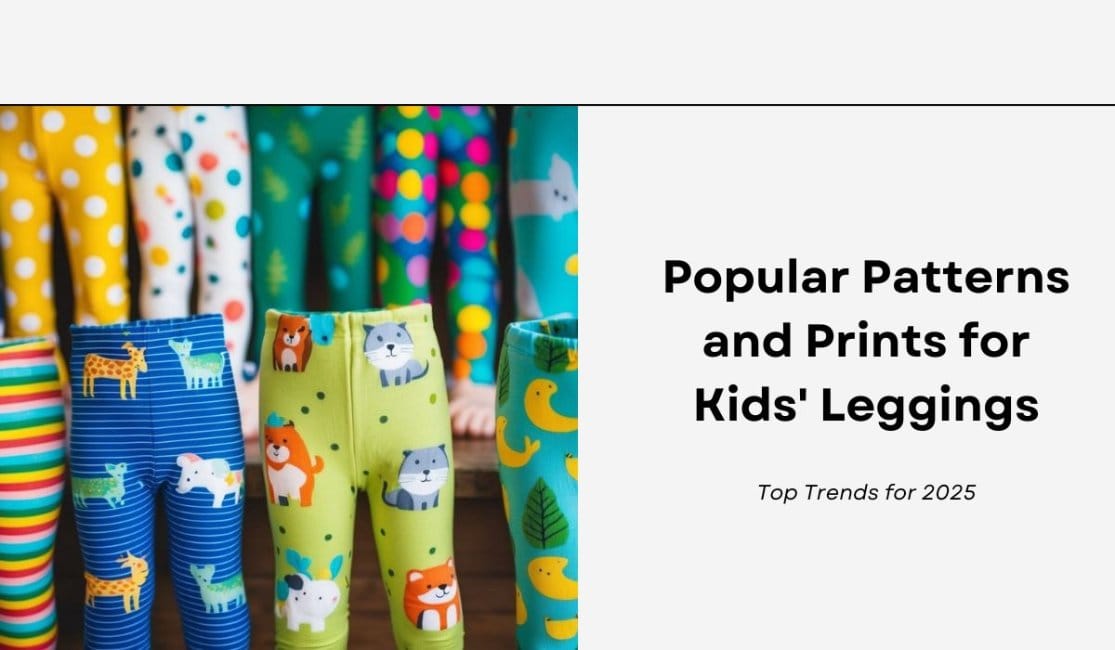From Classic Designs to Trending Prints: A Style Guide to Children’s Winter Legging Fashion
Kids’ leggings are a wardrobe staple for many children. They’re comfortable, versatile, and come in a wide range of patterns and prints. From classic solids to fun animal prints, there’s something to suit every child’s taste and style.
Popular patterns for kids’ leggings include stripes, polka dots, and floral designs. These timeless options never go out of fashion and can be paired with various tops and dresses. For the more adventurous, cartoon characters, superheroes, and space-themed prints are always a hit with little ones.
Seasonal prints are also a great way to keep kids’ leggings fresh and exciting. Think pumpkins and leaves for autumn, snowflakes for winter, and bright fruits for summer. Many parents and children alike enjoy mixing and matching different prints to create unique outfits that express the child’s personality.
On This Page
Key Takeaways
- Kids’ leggings come in a variety of patterns and prints to suit different tastes
- Seasonal prints offer a fun way to update a child’s wardrobe throughout the year
- Mixing and matching prints allows for creative outfit combinations
Understanding Leggings Fabrics
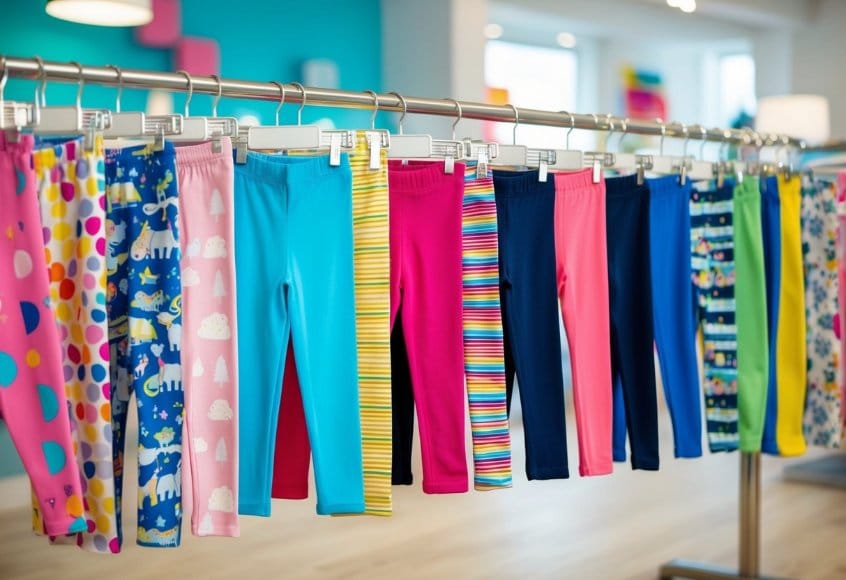
Leggings fabrics play a key role in comfort and durability. The right fabric ensures a good fit and allows kids to move freely.
The Importance of Fabric Stretch
Fabric stretch is crucial for kids’ leggings. 4-way stretch knit fabric is ideal, as it moves in all directions. This type of fabric bounces back to its original shape after stretching.
Look for fabrics with at least 50% stretch. More stretch means better movement and a snug fit. Leggings with good stretch will keep their shape even after lots of wear and washing.
Spandex or Lycra adds elasticity to fabrics. These fibres help leggings hold their shape and prevent sagging at the knees.
Choosing the Right Knit Fabric
Knit fabrics are perfect for leggings. They’re soft, flexible, and comfortable. Medium-weight knit fabrics work best for most leggings.
When picking a knit fabric, check its recovery. This is how well it springs back after being stretched. Good recovery keeps leggings fitting well all day.
Double brushed polyester is a popular choice. It’s soft on both sides and resists pilling. This fabric is also easy to care for and keeps its colour well.
Top Materials: Cotton Lycra and Polyester Blends
Cotton Lycra is a top pick for kids’ leggings. It’s a mix of cotton and spandex or Lycra. This blend is soft, breathable, and stretchy.
Cotton Lycra comes in different weights. Heavier weights are great for cooler weather. Lighter weights work well for summer leggings.
Polyester blends, like rayon spandex, are also common. These fabrics are lightweight and quick-drying. They often have a silky feel and good stretch.
Both materials come in a wide range of colours and prints. This makes them perfect for fun, eye-catching leggings designs.
Essential Sewing Tools and Techniques
Making kids’ leggings requires specific tools and methods. Proper equipment and skills help create comfy, long-lasting garments.
Using the Right Sewing Machine
A good sewing machine is key for leggings. Look for one with stretch stitch options. This stitch lets the seams flex without breaking. Adjust the tension for knit fabrics. Test stitches on scrap fabric first. Some machines have special feet for stretchy material. These help feed the fabric smoothly. Keep the machine clean and oiled for best results. Practice sewing curves on scraps before tackling real leggings. Go slow around tight spots like the crotch seam. A walking foot can help with tricky knits.
The Role of Sergers in Leggings Construction
Sergers make leggings much easier to sew. They trim and finish edges in one step. This creates a neat, professional look. Sergers also add stretch to seams. This is perfect for active kids. Set up the serger with four threads for strength. Use wooly nylon in the loopers for extra stretch. Adjust the differential feed for wavy edges on knits. Test settings on scraps first. Serge seams with right sides together. Trim seam allowances close to the stitching. Press seams to one side after sewing.
Selecting Needles and Threads
Choose the right needles and thread for leggings. Ballpoint needles are best for knits. They slip between fibres without snagging. Use size 70/10 for light fabrics or 80/12 for medium weights. Pick polyester thread for strength and stretch. Match thread colour to fabric or use clear thread. Wind bobbins slowly to avoid stretching the thread. Change needles often, as dull ones can damage knits. Use a stretch twin needle for hems. This creates two rows of stitches with a zigzag underneath. Test needle and thread combos on scraps before sewing the real thing.
Leggings Patterns and Sizing
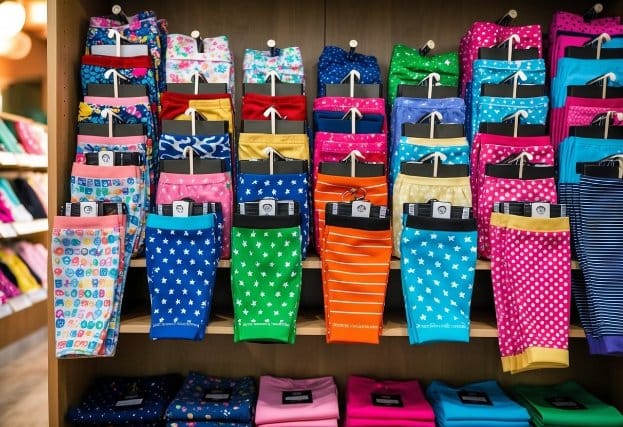
Sewing leggings for kids requires the right pattern and accurate sizing. These elements ensure a comfortable fit and successful project.
Finding the Perfect Sewing Pattern
Many free leggings patterns are available online for children. Look for PDF patterns that offer multiple sizes. These often include detailed instructions and cutting guides.
Some popular options are the ‘Basic Leggings for Kids’ and ‘Free Classic Legging Pattern’. These cover a wide range of sizes, from toddlers to pre-teens.
When choosing a pattern, consider the style and features you want. Some patterns offer different rise options or pocket details.
Understanding Sizing Charts
Sizing charts are crucial for making well-fitting leggings. They help match the child’s measurements to the correct pattern size.
Key measurements include:
- Waist
- Hip
- Inseam
- Height
Take measurements while the child is wearing light clothing. Use a flexible tape measure for accuracy.
Remember that children’s sizes can vary between brands and patterns. Always refer to the specific chart provided with your chosen pattern.
Options for Length: Capri and Full
Leggings patterns often include options for different lengths. The two main choices are capri and full length.
Capri leggings end mid-calf and are great for warmer weather. Full-length leggings reach the ankle and suit cooler temperatures.
Some patterns allow easy adjustment between lengths. This feature lets you make both styles from one pattern.
Consider the season and the child’s preferences when choosing length. Many sewers make both options for versatility.
Adding Elastic Waists
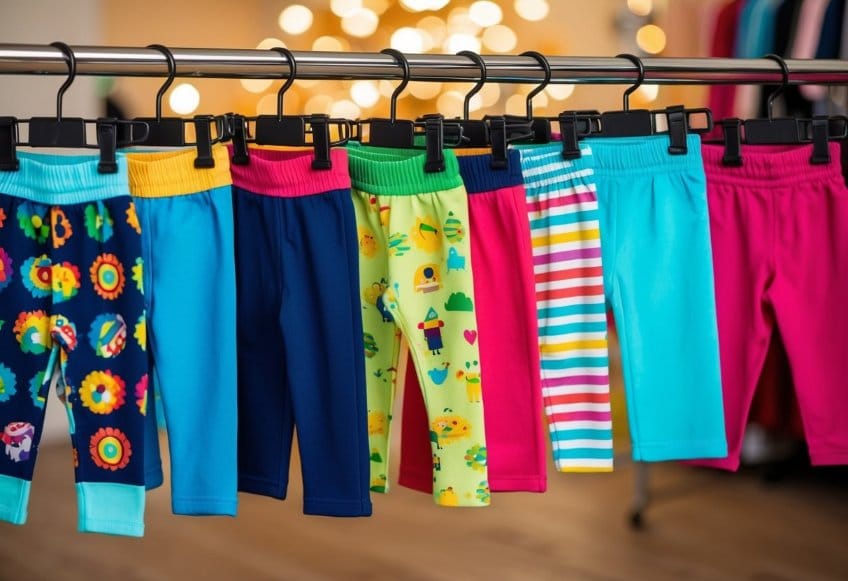
Elastic waists are a key feature of comfortable kids’ leggings. They provide a snug fit while allowing ease of movement. There are two main options for waistbands: elastic and yoga style.
Elastic Waistband vs Yoga Waistband
Elastic waistbands use a casing with elastic threaded through. This creates a gathered look at the waist. Yoga waistbands have a wide, folded-over top without elastic. They sit flat against the tummy.
Elastic waists are better for active kids as they stay in place during play. Yoga waists look sleeker but may slip down. For babies and toddlers, elastic is usually best.
To choose, consider the child’s age and activity level. Elastic works well for most ages. Yoga styles suit older kids and teens who prefer a smooth look.
Sewing Elastic into the Waist
To add an elastic waist, start by measuring the child’s waist. Cut elastic 1 inch shorter than this measurement.
Create a casing by folding the top edge down 1/4 inch, then 1 inch. Stitch close to the lower folded edge, leaving a small opening.
Thread elastic through the casing using a safety pin. Overlap ends by 1 inch and zigzag stitch to join. Stitch the casing opening closed.
For a neater finish, divide the waist into quarters. Pin elastic at these points before stitching the casing. This prevents twisting.
Creative Design Choices
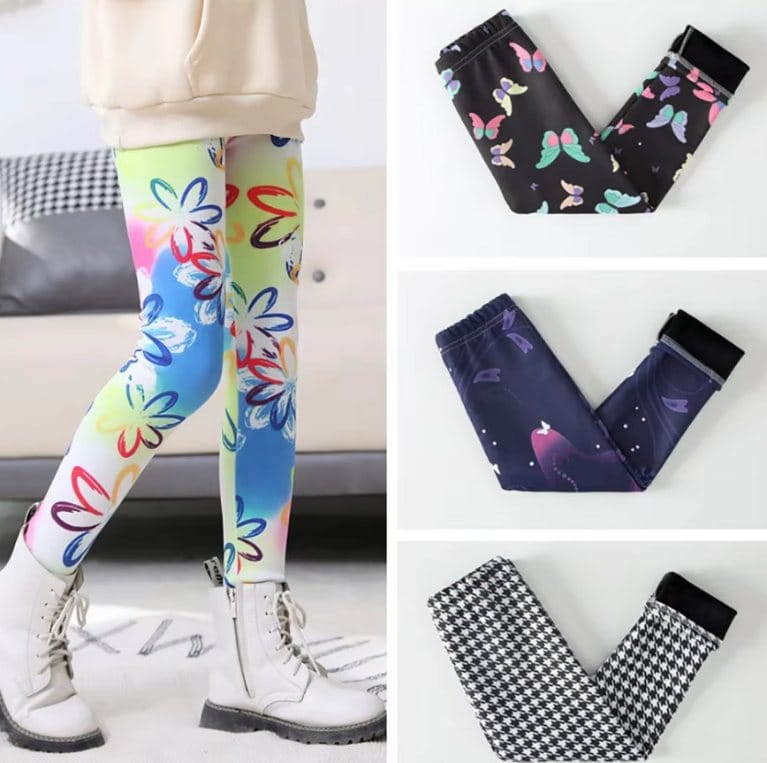
Kids’ leggings offer a canvas for fun and imaginative designs. Clever use of panels, pockets, colours and prints can transform basic leggings into eye-catching garments children love to wear.
Incorporating Contrasting Panels and Pockets
Contrasting panels add visual interest to comfy leggings. Designers often place panels along the sides or knees for a sporty look. Some use mesh panels to create breathable zones. Pockets are both practical and stylish. Side pockets let kids carry small treasures. Back pockets add a jeans-like touch. Cargo-style pockets on the thighs work well for active children.
Colourful panels can highlight leg shapes. Vertical panels make legs look longer. Horizontal panels create a colour-blocked effect. Some brands use reflective panels for safety. Others add decorative appliqués to panels for extra flair.
Experimenting with Colour and Print
Bold colours and fun prints make leggings exciting for kids. Bright solids like red, yellow, and turquoise are popular choices. Pastels work well for softer looks. Designers often use complementary colours to create eye-catching combinations.
Prints range from classic polka dots to trendy galaxy patterns. Animal prints like leopard spots or zebra stripes are perennial favourites. Floral designs suit girly styles. Cartoon characters and superheroes appeal to many children. Some brands offer customisable prints, letting kids design their own leggings.
Pattern mixing is a growing trend. Designers combine different prints in one garment. They might use floral prints on the legs and stripes on the waistband. This approach creates unique, playful looks kids adore.
Decorative Techniques and Finishes
Hemming and topstitching are key techniques for creating professional-looking kids’ leggings. These methods add both style and durability to the garments.
Mastering Hemming and Topstitching
Hemming secures the raw edges of leggings, preventing fraying. A simple folded hem works well for stretchy fabrics. Fold the edge twice, about 1 cm each time, and stitch close to the inner fold. For a neat finish, use a stretch stitch or twin needle.
Topstitching adds a decorative touch while reinforcing seams. It’s often done on the outside of leggings, using a contrasting thread colour for visual interest. Practise on scrap fabric to get even stitches. A guide foot can help maintain straight lines.
Achieving a Professional-Looking Finish
Double-needle stitching creates parallel lines of stitching on the right side and a zigzag on the wrong side. This technique is ideal for hems and waistbands on leggings. It allows for stretch while looking polished.
Press seams and hems flat for a crisp appearance. Use a press cloth to protect delicate fabrics. Topstitch waistbands for a clean edge. Trim excess threads and check for any skipped stitches.
Consider adding decorative elements like appliqués or embroidery for unique designs. These can be machine-stitched or hand-sewn for a personal touch.
Practical Tips for Sewing with Knits
Sewing with knit fabrics requires some special techniques. Using the right tools and methods can make working with stretchy materials much easier.
Handling Stretchy Fabrics
Choose a ballpoint or stretch needle for knits. These needles have rounded tips that slip between fabric fibres without snagging. Use polyester thread, which has some give. Pin or clip fabric pieces together before sewing to prevent shifting.
When cutting knits, use sharp scissors or a rotary cutter. Lay fabric flat and smooth out any wrinkles. Cut with the stretch going around the body for a good fit. For leggings, the greatest stretch should go horizontally.
To prevent wavy seams, avoid pulling the fabric as you sew. Let the feed dogs move the fabric through naturally. A walking foot can help feed knits evenly.
Sewing Stretch Stitches Effectively
Use stitches that stretch with the fabric. A narrow zigzag works well for most seams. Set stitch length to 2.5-3 mm and width to 0.5-1 mm. Test on scrap fabric and adjust as needed.
For hems, try a twin needle. This creates two parallel lines of stitching with a zigzag underneath. It looks neat and allows stretch. Alternatively, use a coverstitch machine for a professional finish.
Press seams as you sew. Use a low heat setting and press lightly to avoid flattening the fabric’s texture. A pressing cloth can protect delicate knits.
Resource Guide for Leggings Making
Making leggings for kids can be fun and easy with the right resources. Free patterns and beginner-friendly tutorials make it simple to get started.
Free Patterns and Resources
Several websites offer free legging patterns for children. The Scattered Thoughts of a Crafty Mom blog provides a basic legging pattern for sizes 3 to 14. SewCanShe offers a free pattern with sizes from 18 months to 12 years. These patterns often come with printable templates and projector files for easy use.
Some sites include extra features like:
- Multiple size options
- Fabric requirement charts
- Cutting layouts
Many patterns are designed for knit fabrics, which stretch and move with active kids.
Tutorials for First-Time Sewers
New sewers can find step-by-step guides to make leggings. Video tutorials are great for visual learners. Sweet Red Poppy offers clear instructions for beginners. These tutorials often cover:
- Fabric selection
- Measuring and cutting
- Sewing seams
- Adding waistbands
Some tips for first-time legging makers:
- Use a ballpoint needle for knit fabrics
- Test stitches on scrap fabric first
- Pin or clip pieces before sewing
With these resources, even new sewers can create cute, comfy leggings for kids.
The Business of Crafting Kids Leggings
Making and selling kids leggings can be a profitable venture. Many parents seek unique, high-quality options for their children’s clothing. This creates opportunities for crafters and small businesses.
Understanding Market Demand for Kids Leggings
Parents often look for comfortable, durable leggings for their children. Stretchy fabrics like those with 5% lycra are popular choices. They allow kids to move freely while playing.
Bright colours and fun patterns tend to sell well. Character designs and seasonal themes are big hits. Many buyers prefer eco-friendly materials and locally made items.
Custom sizing is another selling point. Some children need longer or shorter lengths than standard sizes offer. This gap in the market can be filled by small-scale makers.
Pricing varies widely based on materials and labour. Handmade leggings typically cost more than mass-produced ones. But many parents are willing to pay extra for quality and uniqueness.
Crafting Leggings for Sale
To start making kids leggings, you’ll need a good pattern. Many are available online, both free and paid. It’s crucial to choose one that fits well and is easy to sew.
Fabric selection is key. Look for soft, stretchy materials that wash well. Cotton-lycra blends are common choices. They offer comfort and durability.
Invest in a serger machine if possible. It creates strong, stretchy seams perfect for leggings. A regular sewing machine can work too, but may not be as efficient.
Quality control is vital. Check each pair for sturdy stitching and proper fit. Consider offering a size chart to help customers choose the right fit.
Marketing your leggings can be done through craft fairs, online shops, or social media. High-quality photos showing the fit and fabric are important for online sales.
Contemporary Trends in Kids Leggings
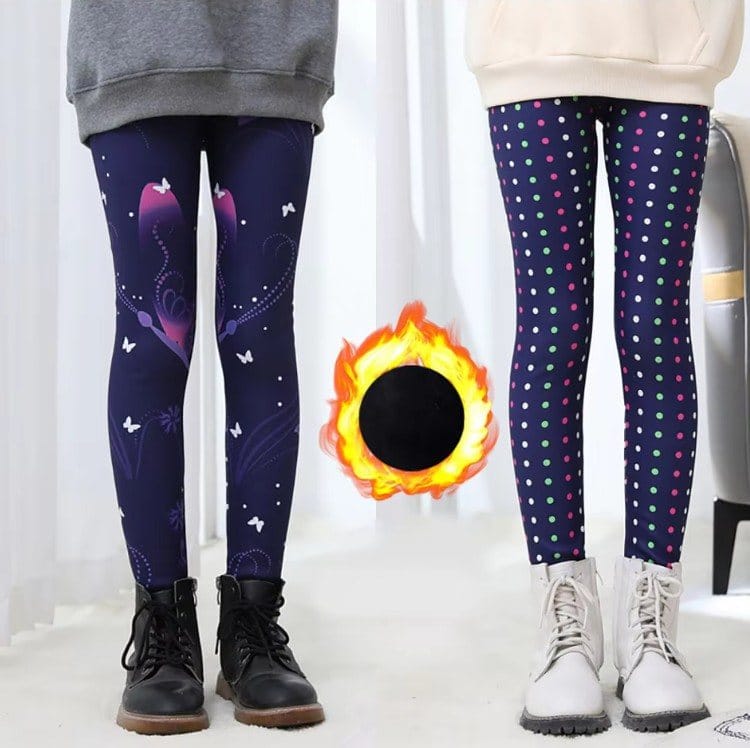
Kids leggings are a staple in children’s wardrobes. They offer comfort and style for active youngsters. Today’s trends focus on fun prints and bold colours.
Animal prints remain popular for kids leggings. Leopard spots and zebra stripes are common choices. These patterns add a playful touch to any outfit.
Cartoon characters feature heavily on fitted leggings for children. Favourite TV and film heroes often appear on these garments. This trend appeals to kids who want to show off their interests.
Bright, eye-catching colours are in demand. Neon shades and rainbow patterns are trendy options. These vibrant leggings allow kids to express their personalities.
Space themes are gaining traction. Stars, planets, and rocket ships decorate many kids leggings. This cosmic trend sparks imagination and curiosity.
Floral prints are not just for summer. Year-round botanical patterns are popular for girls’ leggings. Soft pastels and bold blooms both feature in current designs.
Sporty stripes remain a classic choice. These leggings often come in school colours. They’re perfect for PE classes or casual wear.
Glitter and metallic finishes add sparkle to kids leggings. These shiny options are favourites for parties and special occasions.
Camouflage patterns are trending for both boys and girls. This print offers a cool, edgy look for young fashion enthusiasts.
Frequently Asked Questions
Parents often have questions about making and choosing leggings for their children. Let’s address some common inquiries about patterns, designs, and sourcing options for kids’ leggings.
What are the latest trends in designs for children’s leggings?
Bold prints and vibrant colours are popular for children’s leggings. Animal patterns, especially leopard print, are trendy. Stripes and plaids also feature heavily in current designs.
Many parents opt for fun, eye-catching patterns that reflect their child’s interests. Leggings with characters from popular films or TV shows are in high demand.
Where can I find a simple pattern for sewing children’s leggings?
Several websites offer free patterns for children’s leggings. The Fold Line and Scattered Thoughts of a Crafty Mom provide easy-to-follow templates.
These patterns often come with step-by-step instructions. They’re suitable for beginners and experienced sewers alike.
How can I create homemade leggings for my daughter?
To make leggings at home, start by choosing a stretchy fabric. Measure your child’s waist, hips, and leg length. Use these measurements to select or adjust a pattern.
Cut out the fabric pieces and sew the leg seams. Add an elastic waistband and hem the ankles. With practice, you can make a pair of leggings in under an hour.
What are the most popular themes for printed kids’ leggings?
Animals, space, and nature themes are very popular for kids’ leggings. Dinosaurs, unicorns, and sea creatures often feature in designs.
Geometric patterns and abstract prints are also common. Seasonal themes like flowers for spring or snowflakes for winter are sought after.
How to source child-friendly patterns for making leggings at home?
Look for patterns designed specifically for children’s wear. Online sewing communities and craft stores often stock a range of suitable options.
Consider the fabric’s stretch and recovery when choosing patterns. Some designers offer free tutorials to help you select the right materials.
Where can one discover free sewing patterns for children’s wear online?
Websites like SewCanShe and Sweet Red Poppy offer free leggings patterns for children. These often come in a range of sizes from toddler to teen.
Many sewing blogs provide printable PDF patterns. Always check the sizing chart and print a test square to ensure accurate sizing.

